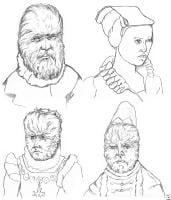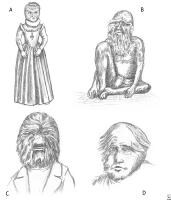Congenital Hypertrichosis Lanuginosa
- Author: Sarah K Taylor, MD; Chief Editor: William D James, MD more...
Updated: May 10, 2012
Background
For hundreds of years, societies have maintained a certain fascination with the bizarre and the unknown. In the past, persons with congenital disorders that cause excessive body-hair growth have been so dramatized and romanticized that individuals with rare hypertrichosis syndromes became crowd-drawing money-making phenomena in many 19th century sideshow acts. Most famously, Fedor Jeftichew, aka Jojo the Dog-faced boy, was exhibited by PT Barnum in the US in the 1800's.
These individuals have been referred to as dog-men, hair-men, human Skye terriers, ape-men, werewolves, and Homo sylvestris.[1, 2] Since the Middle Ages, approximately 50 individuals with congenital hypertrichosis have been described, and, according to the most recent estimates, approximately 34 cases are documented adequately and definitively in the literature .[3, 4, 5]
Disorders of hypertrichosis are distinguished by the distribution of hair, as well as by the temporal pattern of growth, the possible associated congenital anomalies, and the possible inheritance pattern.
Congenital hypertrichosis lanuginosa (CHL) has been referred to variably as congenital hypertrichosis universalis, hypertrichosis universalis, hypertrichosis lanuginosa, and hypertrichosis lanuginosa universalis. The lack of definitive terminology can be confusing and may make the distinction of the related but unique hypertrichosis syndromes difficult .[1, 2, 6, 7, 8, 9, 10, 11, 12, 13, 14, 15, 16, 17, 18, 19, 20, 21] Several solitary case reports describing hypertrichosis resembling congenital hypertrichosis lanuginosa in association with other physical findings may, in fact, represent variants in a spectrum of the disorder.
An X-linked syndrome of hypertrichosis associated with gingival hyperplasia has been described. The abnormally excessive body hair that these patients develop is of the terminal type, and this disorder will not be greatly discussed. However, the X-linked syndrome of hypertrichosis associated with gingival hyperplasia is often confused with congenital hypertrichosis lanuginosa. Of interest, Julia Pastrana (1834-1860), one of the most famous persons with generalized hypertrichosis, was long thought to have congenital hypertrichosis lanuginosa. After her death, her hairs were found to actually be terminal in nature, indicating that she likely had hypertrichosis with gingival hyperplasia and not congenital hypertrichosis lanuginosa. This illustrates the need to accurately determine the type of excess hair present on a given patient.
In addition, the localized hypertrichoses, including primary hypertrichosis cubiti (hypertrichosis of both elbows), primary cervical hypertrichosis, and primary faun tail deformity, are not addressed in this article .[22] These forms represent limited types of hypertrichosis that may be associated with underlying bone and neurologic abnormalities. Hence, they can be distinguished from congenital hypertrichosis lanuginosa on the basis of their clinical presentations.
In 1648, Aldrovandus first documented a family with hypertrichosis. Originally from the Canary Islands, Petrus Gonzales was brought to France as a curiosity for the nobles. He, his 2 daughters, a son, and a grandchild were affected. This kindred was dubbed the Family of Ambras after a castle near Innsbruck where their portraits were discovered. Over the next 300 years, more than 50 similar-appearing cases were described, and 34 patients with presumed congenital hypertrichosis were identified. In 1873, Virchow described an edentate form; in 1876, Bartles added the descriptor "universalis;" and, in 1890, Chiari called the syndrome "hypertrichosis of the dog-men."
 Family of Petrus Gonzales, who lived in the 16th century.
Family of Petrus Gonzales, who lived in the 16th century.
The hairy family of Burma has a 4-generation pedigree of congenital hypertrichosis lanuginosa dating back to 1826. Earlier generations were in the employ of the Ava court, but later generations often earned a living as sideshow attractions in the 1880s.
In 1993, Baumeister et al noted that 9 of these 34 patients with hypertrichosis had a distinctive clinical presentation.[3] The term Ambras syndrome was coined, and subsequent genetic analyses in 2 patients have revealed an association with a paracentric inversion of band 8q22.
 Patients in well-documented cases of Ambras syndrome. (A) Daughter of Petrus Gonzales. (B) Grandson of Schwe Maong. (C) Adrrian Jepticheff. (D) Fedor.
Patients in well-documented cases of Ambras syndrome. (A) Daughter of Petrus Gonzales. (B) Grandson of Schwe Maong. (C) Adrrian Jepticheff. (D) Fedor.
No comments:
Post a Comment